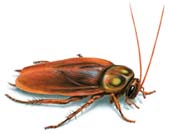
The American cockroach is the largest species of common cockroach, and often considered a pest. American cockroach adults grow to an average length of around 4 centimetres . They are reddish brown and have a yellowish margin on the body region behind the head. Immature cockroaches resemble adults except that they are wingless. The insect can travel quickly, often darting out of sight when someone enters a room, and can fit into small cracks and under doors despite its fairly large size. It is considered on e of the fastest running insects. This cockroach thrives in warm, damp environments, such as sewers, roof voids, wall cavities. It will be found living and breeding outdoors.
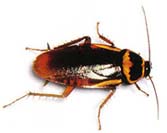
The Australian Cockroach is a large species of cockroach, winged and growing to a length of 30-35 millimetres. It is brown in colour. It is very similar in appearance to the American Cockroach and may be mistaken for it easily. However, it is slightly smaller than the American cockroach, has a yellow margin on the thorax, yellow streaks at its sides near the wing base.
The Australian cockroach usually invades roof voids, where it finds conditions similar to that found within a tree hole (its natural habitat). Once populations grow large inside these sites, the cockroaches regularly venture down into the home. The occasional cockroach may wander into a home from harbourage outside, but chronic infestations are most always associated with roof void or cavity wall infestations.
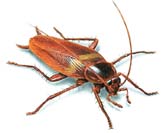
The German cockroach is one of the most troublesome domestic pests that can also be found in restaurants, hotels and other establishments. Typically measuring 1.1 to 1.6cm in length, these pests often enter buildings in times of cold weather and are attracted to certain foods such as meats, sugars and fatty foods. They’re able to reproduce faster than other cockroach species, with the egg to adult cycle taking just 50 to 60 days.
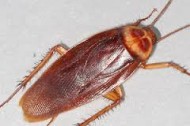
The smoky brown cockroach is a large winged species of cockroach that’s closely related to the American cockroach but has a darker brown colouring. These pests are scavengers that can feed off a range of organic matter, including decaying matter. They typically enter a building to search for food, but in warmer weather, they usually move outdoors. They’re most commonly found in the warmer Australian cities, such as Sydney and Brisbane.
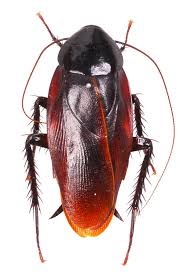
Cockroaches are among the most common of insects, fossil evidence indicates that cockroaches have been on earth for over 300 million years. They are considered one of the most successful groups of animals. Because cockroaches are so adaptable, they have successfully adjusted to living with humans. About 3.500 species of cockroaches exist worldwide, with 55 species found in the United States. Only four species are common pests in Pennsylvania structures. These are the German, Brown Banded, Oriental, and American cockroaches. A fifth species, the Pennsylvania wood cockroach is an occasional nuisance pest in some locations.
Adult male brown banded cockroaches are about 1/2 inch long and light brown, with fully developed wings. The adult females are shorter and stouter than the males and their wings do not cover the entire abdomen. Both adults and nymphs can be distinguished by the two brownish, broad bands across the body at the base of the abdomen and at mid-abdomen. Both males and females are quite active; adult males fly readily when disturbed. Brown banded cockroaches prefer warm and dry locations, such as near refrigerator motor housing, on the upper walls of cabinets, and inside pantries, closets, dressers, and furniture in general.
They can also be found behind picture frames and beneath tables and chairs, and inside clocks, radios, light switch plates, door frames, and dressers. It is common to find them hiding nearer the ceiling than the floor and away from water sources. Accurate identification is paramount to controlling brown banded cockroaches. Control strategies for other cockroaches will not be efficacious for brown banded cockroaches. The brown banded cockroach has three developmental stages; egg, nymph, and adult. Eggs are laid in capsules, which the female carries for about 30 hours before she fastens it on walls, ceiling, and in protected and hidden areas. During her adult life a female produces about 14 egg capsules, each containing an average of 13 eggs. The length of the egg stage varies from 37 to 103 days, depending on temperature. The nymphal stage range from 8 to 31 weeks. A female adult has a life span of 13 to 45 weeks; each female produces about 600 descendants per year.
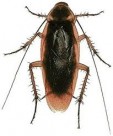
Oriental cockroaches are often called water bugs because of their preference for dark, damp, and cool areas such as those under sinks and washing machines, and in damp basements. This species, which is less wary and more sluggish than the others, of concern because it often travels through sewer pipes and lives on filth. Adult Oriental cockroaches are about one inch in length. Both male and female adults are very dark brown, nearly black; their bodies usually have a somewhat greasy sheen. Females have small, function-less, rudimentary wing pads and broader, heavier bodies. Males have wings that cover only about three-quarter of their abdomen.
Males are apparently unable to fly. Nymphs and adults have similar habits and are found with decaying organic matter indoors and out. Indoors, Oriental cockroaches prefer dark, moist areas, such as under porches, sewers, drains, crawl spaces, dark, damp basements, and floor drains. They can be found outdoors in abandoned cisterns and water valve pits; in yards; beneath leaves; in bark mulch around shrubs, flowers, and foundations; in dumps, stone walls, and crawl spaces; and in garbage and trash dumps and trash chutes. Both nymphs and adults are sluggish and are usually situated at or below ground level indoors. They are seldom found on walls, in high cupboards, or in the upper floors of buildings. At times large numbers occur in one great mass around leaks in the basement or crawl space areas of homes.
Oriental cockroaches are generally found outdoors during warm weather, but in periods of drought there may be considerable movement into structures, apparently in search of higher humidity. They may enter the home in food packages and laundry, or merely come in under the door or through air ducts, garbage chutes, or ventilators.
The Oriental cockroach has three developmental stages; egg, nymph, and adult. Eggs are laid in capsules, which the female carries for about 30 hours and then drops onto a protected surface near a food supply. The female does not glue the egg capsule to the surface. Females produce an average of eight capsules, each containing 16 eggs that hatch in about 60 days under room temperature conditions. Nymphs molt from seven to ten times; nymph stages usually take 24 to 130 weeks to complete. The life span of an adult female is 5 to 26 weeks with approximately 200 offspring. Unlike the other house-infesting species, the Oriental cockroach generally has a seasonal developmental cycle. The peak number of adults usually appears in late spring or early summer. By late summer and early fall, this number has become quite low, owing to natural mortality and the hatching of nymphs.
